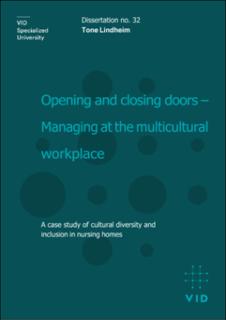| dc.description.abstract | Immigration has changed the demographics of Norway remarkably over the last 50 years as it has in many other countries, and immigrants are working their way into society and into the labor market. These changes pose new challenges to managers and employees in the multicultural workplace, and they raise new questions for management and organization research. Therefore, this study addresses the following question: How do organizational practices enhance and hinder inclusion in the multicultural workplace? Inclusion encompassesthe first step of immigrants accessing the workplace through employment and stable participation in the labor market, as well as the following steps of being socialized in the organizational community with its expectations for management and employee behavior. In the inclusive workplace, the special competence of immigrants is acknowledged and used. In the process of inclusion, managers in general, and middle managers in particular, are in the position of opening and closing doors for immigrant employees.
To better understand organizational practices in the multicultural workplace, a case study of three nursing homes in Oslo, Norway, with a high percentage of employees with an immigrant background, was conducted. Nursing homes with different operating structures were chosen: one run by the municipality, one run by a non-profit entity, and one run by a for-profit entity. In the case study, an ethnographic approach was applied, combining different methods for generating data: participant observation, semi-structured shadowing, interviews, and document analysis. The three chief executive officers (CEOs) of the nursing homes, two unit managers from each nursing home (one with an immigrant background and one with a majority background), and six employees from each nursing home were interviewed. The datamaterial of the study consists of field notes from 200 hours of observation and transcripts from 27 interviews.
Organizational practices in nursing homes are analyzed from an institutional and a practice- theoretical perspective. The institutional lens brings into focus how practices are embedded ina context with regulative, normative, and cultural-cognitive features. The practice-theoretical lens captures the complexity and connectedness of organizational practices. Connecting thesetwo theoretical traditions in a practice-driven institutionalism enriches the understanding of practices, zooming out on the wider societal context with its legislation and norms, and zooming in on practices as they are accomplished in the everyday life of the nursing homes.
Each of the three articles of the thesis offers partial answers to the overall research questionand contributes to research in the fields of diversity management, institutional theory, and practice theory. Article 1 argues for an understanding of inclusion that starts with gaining access to the workplace through secure and stable employment. The use of practice theory reveals how the net effect of recruitment-related practices in nursing homes is that many immigrant employees remain in uncertain employment. Article 2 challenges the use of cultural universals to compare cultures at the societal level and argues that this approach is too narrow when it omits contextual institutional factors and too general when it does not consider organizational-level factors. As an alternative, the article develops the concept of dynamic cultural configuration and suggests inquiring into these configurations holding cultural categories loosely. Article 3 asks how the multicultural workplace may access and use the special competence of immigrant employees to develop religious literacy to provideequitable services to residents with a minority background. In this process, managers play a crucial role, promoting an organizational culture that welcomes religion into the workplace and facilitating conversational spaces characterized by psychological safety among employees.
The study contributes to diversity management research by applying perspectives of a practice-driven institutionalism. The concept of dynamic cultural configuration contributes tocross-cultural management research. Connecting theoretical perspectives from different streams of research, such as institutional theory and practice theory, and linking perspectives from sociology of religion and adult education broaden the understanding of diversity management practices in the multicultural workplace.
Paper I: Lindheim, T. (2021). Ambiguous practices and conflicting interests: why immigrants end upin uncertain employment. Equality, Diversity and Inclusion. 40 (5), 542-558 http://dx.doi.org/10.1108/EDI-02-2020-0046 Not in the file in Brage because of copyright restrictions.
Paper II: Lindheim, T. (2020). ‘Good leaders do the dirty work’. Implicit leadership theory at the multicultural workplace. In H. Askeland, G. Espedal, B. J. Løvaas, & S. Sirris (Eds.),Understanding values work. Institutional perspectives in organizations and leadership, pp. 97–115. Palgrave. http://dx.doi.org/10.1007/978-3-030-37748-9_6 Not in the file in Brage because of copyright restrictions.
Paper III: Lindheim, T. (2020). Developing religious literacy through conversational spaces for religionin the workplace. Nordic Journal of Religion and Society, 33 (1), 16–29. http://dx.doi.org/10.18261/issn.1890-7008-2020-01-02 Not in the file in Brage because of copyright restrictions. | en_US |
